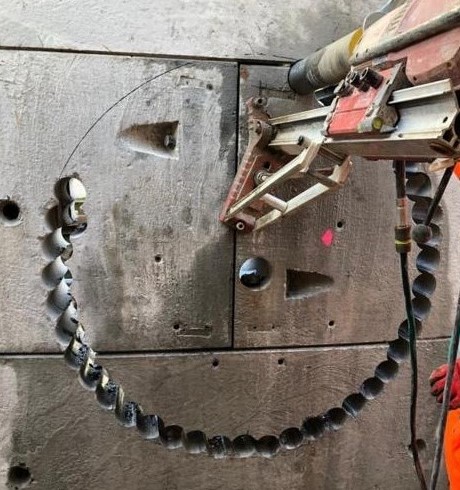

Myths About Diamond Drilling and Diamond Sawing
Using diamonds in the drill bits and saws has been a common practice for a long time now. Diamond drilling and sawing is a boon to the industry and has increased the productivity and ease of the task exponentially. Though the practice has gained popularity because of its proficiency, there are always certain myths and misconceptions floating around about the job. When a contractor invests in a diamond drill bit or a saw, they often wear it out ahead of its standard life span due to the lack of proper knowledge about the latest instruments. Apart from the operators, there is confusion about the concrete cutting process even among the layman as ‘diamond’ and ‘drilling’ are rarely heard together in one sentence outside of the industry.
Learn About Diamond Drilling and Sawing
In order to bust some myths about concrete cutting, we need to understand the process of diamond drilling and sawing. There are instruments called drill bits that are adorned with fine diamonds, not for the sake of embellishment but because it is the hardest material in the world. Hence, there is a good use of such diamond-clad instruments for cutting through extremely hard substances like concrete with utter ease and precision. Diamond drilling can be used for resting a particular sized hole through the slabs as well as for exploration purposes like core drilling. Diamond sawing, on the other hand, is extremely effective for cutting through concrete structures of varying masses.
Myth 1: Concrete Cutting is Messy
This is a complete misconception in the case of diamond drilling through concrete. The process leaves little debris behind and there is very little dust mess created on the site. Having minimal rummage after the procedure is one one the most desirable advantages of the whole diamond drilling through the concrete process. Some dust that is created, can easily be minimized using various tips like water.
Myth 2: No Special Training is Required for Operation
Some might think that it is the same as operating a mechanical drilling machine, but diamond drilling requires quite a lot of specialized training about the equipment and the handling to be able to use it meaningfully whenever required. As and when diamond drill bits become a common part of people’s everyday toolbox, it is necessary to stress the fact that everyone should seek some advice and training about their function and maintenance beforehand too ensure the longevity of the same. Other than the mechanism, the operators also need to understand the safety measures and precautions that should be taken to avoid any risks of damage.
Myth 3: One Blade Suits All
This statement is the farthest from the truth. Yes, diamond blades are versatile and can saw through various different kinds of materials. But, No, a singular blade is not bestowed with the appropriate specifications to cut through different material. Each blade is manufactured with a designated purpose and comes with different chip size for crystals, mesh size, and also the number of diamonds. One can choose the appropriate diamond saw blade based on the style, grade, and cutting requirements of the job at hand.
Myth 4: Cutting With Water Makes Blades Last Longer
Wet cutting is a common practice when using a diamond saw blade. It is really beneficial for obtaining a clean and precise cut and having beyond ar outcomes. However, the fact that it will help increase the blade’s life is dubious. It does help in evading the wear and tear that might occur due to the production of heat during the process, but it is contrasted by the creation of abrasive slurry which can add a bit of wear to the saw blade. The use of water is recommended by all the guidelines as it prevents dust and warping of the blade due to overheating.
In Conclusion, Conduct Research and Learn Facts
Diamond drilling and sawing are known to be extremely efficient, noise-free, non-percussive, and accurate ways of drilling holes and cutting into concrete. The drill bits come in different sizes and can vary from small to large as per the job’s requirements. Read about these facts in detail and then put the theory into practice for accurate results. The myths can lead someone astray but fact-checks can always help in figuring out the correct method, tool, or material for concrete cutting.
FAQs
How Diamond Drilling works?
In diamond drilling, a rotary drill with diamond bits is used to obtain precise and clean holes ranging from 8mm to 150mm. This drilling technique is usually implemented in the drilling of hard structures such as asphalt, metal concrete, etc.
What is diamond drilling?
Diamond drilling is a core drilling technique used by professional contractors for creating precisely measured holes using rotary drills with diamond bits. Diamonds are the hardest natural materials and diamond drilling techniques are designed to use their rigorousness to pierce through concrete, metal, asphalt and other materials that are difficult to cut through otherwise.
What is diamond drilling used for?
Diamond drilling is used to create accurate and precise openings in rigid structures. It is used at construction sites and in renovation or partial demolition projects.
How diamond drilling works?
In diamond drilling, an operator uses a rotary drill mounted with industrial-grade diamonds to obtain clean and precise openings in concrete and other rigid structures. Diamond drills can be operated horizontally as well as in a vertical direction depending on the project requirement.
What does a diamond driller do?
A diamond driller is a trained professional who is skilled in operating special equipment such as diamond drills. They are proficient in creating precise openings on a building site or cutting through rough surfaces in a demolition project, using diamond drills.
What is diamond drilling in construction?
Diamond drilling is a versatile method of drilling that can be used in a wide variety of construction projects. It is used to create precise and smooth holes in hard surfaces such as concrete, asphalt etc
- Search
- Categories
- Achilles Building Confidence
- Blog
- Brokk demolition
- Certificate
- Concrete Cutting
- Controlled Demolition
- Diamond Concrete Cutting
- Diamond Concrete Drilling
- Diamond Drilling
- diamond drilling london
- Diamond Sawing
- Fire doors
- Floor Preparation
- Hydraulic Bursting
- Magnetic Drilling
- Passive Fire Protection
- Stitch Drilling
- Archives
